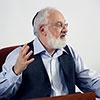Audio Version Of The Blog – 2/19/20
Listen to an Audio Version of the Blog
Download:MP3 Audio

Listen to an Audio Version of the Blog
Download:MP3 Audio

When a person feels insignificant, and egoism has no power over him—he can then enter the upper world. The importance of the spiritual work is measured by the sensation of descent. Because the Creator hates egoism.
Baal HaSulam: Direct all your thoughts to the Creator. Don’t do anything that does not bring you closer to Him. Hence all actions must be for the benefit of others. That is how you will reach equivalence with Him just as all of the Creator’s actions are for the good of the creatures, so should you imitate Him. You will thereby attain adhesion with Him!
Baal HaSulam: Just as the Creator doesn’t think about Himself, whether He exists or not, so one wishing to attain equivalence with the Creator mustn’t think about himself, because it is precisely in thoughts of himself that he separates from the Creator and will not reach closeness with Him and His revelation.
One who wishes to reveal life must develop his point in the heart. It is present in every person, but does not shine. This is an embryo of the quality of bestowal, the soul.But it is in the “dust”—that is, a person does not have any regard for it. One must pay great attention to develop it till the soul appears in it.
After the breaking of the soul, its broken parts, we, the creatures, are considered dead—wishing to receive only for ourselves, and therefore separated from the Creator. And only the point in the heart, a record of the reflected light, which has remained of the will to bestow supports an opportunity in us to revive ourselves.
When a person is born, the embryo of the soul called “the point” appears in him. It is found in a person’s desire, called “Heart.” Therefore the aspiration to the Creator is called “the point in the heart.”
From Twitter, 2/19/20
Related Material:
My Thoughts On Twitter 2/18/20
My Thoughts On Twitter 2/17/20
My Thoughts On Twitter 2/16/20
 From My Facebook Page Michael Laitman 2/19/20
From My Facebook Page Michael Laitman 2/19/20
If we used to caution our kids about talking to strangers and walking in side alleys, today they sit at home with their mobile devices and all the dangers are at their fingertips.
The latest dangerous viral trend, the Tripping Jump Challenge (a.k.a. Skull Breaker Challenge), distributed on the social app, Tik Tok, has already led to death and injury.
In the challenge, three people line up and jump at once. The participant in the middle is unaware of the prank, told that they are simply recording a slow-motion video of the jump. After the jump, the two on the sides proceed to trip the unsuspecting participant in the middle, while they are in the air, so that they fall backwards.
The “best-case scenario,” if you could call it that, is shock and taunting of the one who got pranked. This is also why the participant who gets pranked is often also not a friend of the pranksters, but a victim of bullying.
The worst-case scenario, however, is much worse: death and severe injury.
The tragic nature of this phenomenon shows us how we are incapable of controlling ourselves as a society.
It is not the first viral challenge that has led to harming and killing its participants. Also, once again, it has taken death and injury for us to wake up to the problem and try to apply a patchwork solution, until the next case comes along.
We have the means at our disposal to restrict the Internet so that such negative phenomena stay away from our children and teenagers.
We can demand that international organizations oversee the Internet, determining and monitoring what is allowed and disallowed.
Also, we can do so not only when it comes to the question of harsh violence and porn, but upon everything contemptuous and slanderous.
We could raise youth awareness to be better equipped in dealing with the freedom they have on the Internet.
But we don’t.
Moreover, if we wanted to, we could impact a revolution by instigating a new form of education spanning the education system as we know it, in addition to media and cultural influences that shape our values—connection-enriching education that aims to clarify how a positive future depends on actively developing positive social connections.
Since most of the complaints about the harm caused from such incidents come from concerned parents, then this appeal is primarily to the parents: With your common concern for your children, unite and together break the social consensus that everything is permissible. Otherwise, tomorrow your child could very well be the next victim.

 Michael Laitman, On Quora: “Do you think that each person has its key to happiness and why is that?“
Michael Laitman, On Quora: “Do you think that each person has its key to happiness and why is that?“
Each and every person holds a key to happiness. However, it can only be activated and applied when in positive connection with other people.
There is an expression that habit becomes second nature. In our daily lives, we concentrate solely on our own problems and concerns. It is simply how we are built. Naturally, we think only about ourselves and our closest environments.
Nevertheless, our sensation of happiness depends on our engagement in social interaction and communication. Much recent research in the fields of happiness science and positive psychology certifies this point. Therefore, in order to become genuinely happy, we need to change the direction of our daily habits and concerns from benefiting ourselves to benefiting others, or in other words, to stop thinking about ourselves and start taking care of others.
How can we undergo this transformation?
We can do so by gathering several people into a supportive environment, where each member will be directed at the same goal: positive connection above division in order to discover the most harmonious states we can experience, including true happiness, love, freedom and peace.
Then, in such an environment, we will need to undergo connection-enriching education, regularly training our hearts to act in mutual encouragement, support and respect toward one another above a constantly growing ego within us operating in the other direction, to exploit others for its own benefit.
By doing so, we will gradually achieve a balanced state in society, one where we will experience true and lasting happiness.
Happiness, therefore, is in our hands, but we hold it together. We are mutually dependent on and responsible for each other in order to achieve true happiness, and we thus require a certain learning method and framework in society.
That is what the wisdom of Kabbalah offers. It is a method for connection that anyone can apply in order to exercise positive connections in society above our divisive drives, and by doing so, reach harmonious states that we have never before experienced or imagined.
 Between The Devil And The Deep Blue Sea.
Between The Devil And The Deep Blue Sea.
Only by truly overcoming all the obstacles that constantly knock me down and lead me off the right path, through faith above reason, when contrary to what I see I still attach all events and all sources of influence to the Creator, despite what I see, I realize that He clothes himself in different people, forces, and events. This is the only way I can make efforts to correct my perception of the world and seek the Creator.
But I do not always have the strength to overcome all these doubts and setups, and cling to the Creator. Not always can I see the Creator through all sources by faith above reason through my efforts and contrary to what I see. Although they are very serious and threatening, I still have to see the Creator through them.
Such a search is called “faith above reason,” when I rush to Him contrary to what I feel. If I cannot resist this, then I fall into the feeling of our world and see only it.
Therefore, the beginning of the spiritual path is to start determining the Creator in all the actions we feel upon ourselves and in what is happening not only around us, but also within ourselves—how I react to the fact that the Creator plays me through all kinds of external figures.
And here, too, I do not react, it is not me: I do not have anything independent, this also is the Creator. It turns out that I am in the middle between how the Creator influences me from the outside and how the Creator influences the outside world from within me. It is in the middle between these two sources of the correct intention that there is no one but Him, that I must find my clear state.
Baal HaSulam writes that in this search a person always has more downs than ups. One always has more failures in one’s attempts to discover the Creator, become strong in Him, direct oneself to Him, and see the Creator in every action.
There are very few such conditions. Far more than others, when I fall I see only the outside world and myself in this world, i.e., not the Creator from within and the Creator outside, but myself and the outside world. This is, we might say, our tragedy.
The state where I feel “The outside world and me” is called a descent. The state when I feel that the Creator is within me and outside of me is called an ascent.
What does it mean that the Creator is within me? It is the fact that I feel how He twists me. He does not give even my inner effort to rush directly to Him, to see this world as His work.
Here I really am between two fires—from within I am always deceived and from the outside too. Such a twofold adjustment “both inside me and outside” is called “adjustment to the Creator,” that there is no one but Him and I do not exist, there is no external world, but there is only one Creator.
And who am I? I am the point that is between two influences: internal and external.
[256641]
From KabTV’s “Fundamentals of Kabbalah,” 11/24/19
Related Material:
The Uniqueness Of The Force Governing Us, Part 2
The Uniqueness Of The Force Governing Us, Part 1
The Right Adducts And The Left Rejects
 From the Yom Kippur to Hanukkah
From the Yom Kippur to Hanukkah
Question: During Yom Kippur (the Day of Atonement) a person makes a restriction on all one’s desires because one wants to become similar to the Creator and not receive anything. Then a person corrects all one’s seven types of desires and on the eighth day receives the Torah, the light. Then comes Hanukkah. What does this holiday symbolize?
Answer: Hanukkah symbolizes the correction of a person to the state when one reaches the quality of Bina, the quality of complete bestowal. From Malchut one rises to the Sefira of Bina where one is completely in bestowal and does not need to receive anything.
Question: Does it mean that one has already corrected the seven first Sefirot during Sukkot and now has ascended to Bina?
Answer: No. These are all nominal, private corrections, not at full capacity. After all the holidays, precisely by receiving the Torah (upper light), one begins to correct oneself.
Until the end of Sukkot, until Shemini Atzeret, a person is not being truly corrected. A person did all the preparatory work to attract the upper light upon oneself.
Starting from the end of the holiday of Sukkot, from Shemini Atzeret to Hanukkah, one corrects oneself in the quality of Bina, in the quality of bestowal.
Question: Hanukkah represents a historical event that took place in the second century BC: an ideological conflict between the Maccabees and the Greeks. According to Kabbalah, the Greeks represent our egoistic desires and the Maccabees represent our altruistic desires.
The most interesting thing is the miracle that happened during Hanukkah. What is it?
Answer: The Maccabees found a small jar with the seal of the High Priest (Cohen), which contained the oil usually used in the Temple. From this oil they lit a lamp, and it burned all seven days of Hanukkah.
This is considered the miracle of Hanukkah and represents the fact that if a person correctly prepares oneself from below and is ready to be both the oil and the candle, then the Creator completely corrects the person, and one reaches one’s complete correction in the upper light of Bina, meaning one rises to the level of complete bestowal.
Question: Does it mean that a candle, a wick, and oil symbolize certain actions that a Kabbalist does with his or her desires?
Answer: Yes. And Hanukkah itself is “Hanu-Koh,” a stopover, when a person finishes correcting oneself in the quality of bestowal and moves to the next degree to the correction in the quality of reception for the sake of bestowal.
[257493]
From KabTV’s “Fundamentals of Kabbalah,” 1/29/19
Related Material:
Spiritual Holidays, Part 5
Spiritual Holidays, Part 4
Spiritual Holidays, Part 3
New Life 1171 – The Dangers In A Connected World
Dr. Michael Laitman in conversation with Oren Levi and Nitzah Mazoz
Our situation is dangerous because humans have an evil, egoistic inclination to begin with and today there are many technological opportunities to exploit and take advantage of others. Treatment of the evil root of human nature is the only way to protect us from what is expected to come as it continues to grow, develop, and intensify. Our harmful thoughts and our bad relationships also destroy the ecological environment since nature is a single system. It is up to us to bring out the positive force in nature and exist between the two forces so that all of humanity can achieve a good connection based on mutual help, friendship, and love. When we do, we will feel unlimited, without any distinctions between myself and others. We will break through into another eternal level of existence.
[254698]
From KabTV’s “New Life 1171 – The Dangers In A Connected World,” 10/29/19
Lesson Preparation
| [media 1] | [media 2] |
Lesson on the Topic “Only Through The Ten To The Creator” (Preparation for the Convention in The World Kabbalah Convention 2020)
| [media 3] | [media 4] |
Selected Highlights
| [media 5] | [media 6] |